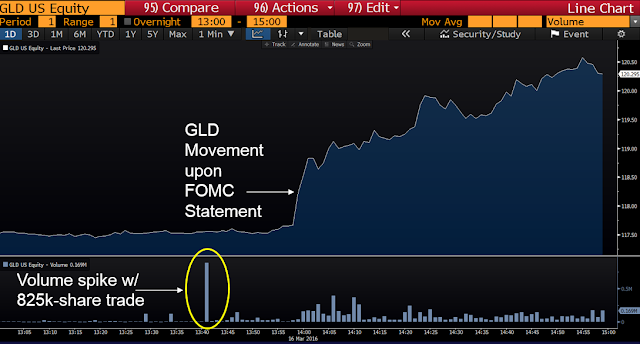Last Wednesday the Fed concluded its two-day Federal Open Market Committee (FOMC) meeting and issued its statement, deciding to hold the Fed Funds rate between 0.25% and 0.50%, as expected. The accompanying economic projections show that Fed policy-makers currently expect to raise rates only twice this year, down from their December median projection of 4 rate hikes in 2016. Markets responded in kind to the Fed’s more accommodating monetary stance, with 2-year yields falling, the dollar weakening, and gold rallying.
One of our readers passed along a chart showing an 890,000 share spike in volume in GLD (the SPDR Gold Shares ETF) about 20 minutes before the 2:00 FOMC statement release — a volume spike which doesn’t create any noticeable spike in the market. We dug into Bloomberg’s “Trade/Quote Recap” data and found that there was a single execution of 825,000 shares.
Source: Bloomberg
Our reader was suspicious of the timing, suggesting that perhaps the statement and updated projections had been leaked.
We certainly would not dismiss the possibility of information leakage and the timing of the block trade certainly is curious, but it’s worth being skeptical in this instance: there are plenty of innocent explanations for a block trade in GLD — even one so close to the release of the FOMC statement:
First up, is a trade of 825,000 shares of GLD all that unusual? According to Bloomberg, and not counting opening and closing crosses, there were 36 trades of 500,000 shares or more (ranging up to 1.8 million shares per trade) in the previous 30 trading days. So while trades of half a million shares or more of GLD are not exactly an hourly occurrence, they do occur slightly more than once per day.
Next, we cannot ignore the (albeit remote) possibilities that (1) investors (or traders) weren’t targeting the vanilla GLD, as much as delta-hedging a large options position or (2) that the GLD transaction was part of an arbitrage strategy in which a trader bought or sold GLD shares against a short or long position in gold futures. (If we assume a delta of .50 for an at-the-money option, then an 825k share cash position suggests the options position would be around 1.65 million shares, or 16,500 contracts.)
Finally, we can’t be sure that this trade was initiated by a buyer — there are, of course, two sides to every trade.[1] Perhaps the customer initiating the trade was a seller and the broker-dealer bought the block (or found the other side of the trade) in order to facilitate a customer sell order. In other words, maybe it was a large seller, looking to get out of a long position before the Fed decision. We have no way of knowing which side of the trade the customer was on, nor whether the broker-dealer took principal risk or found the other side of the trade. (FINRA would, however, be able to dig further, if so inclined, via the OATS system, which enables them to monitor the detailed history and execution of orders.)
--------------------------------------
[1] We do know, per Bloomberg, that the trade was reported via FINRA’s ADF, which means that the execution did not occur on an exchange. So, it could have occurred in a dark pool or other Alternative Trading System (ATS) venue, but more likely it was done through an institutional broker.

No comments:
Post a Comment